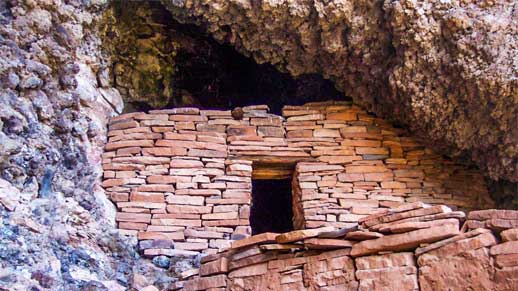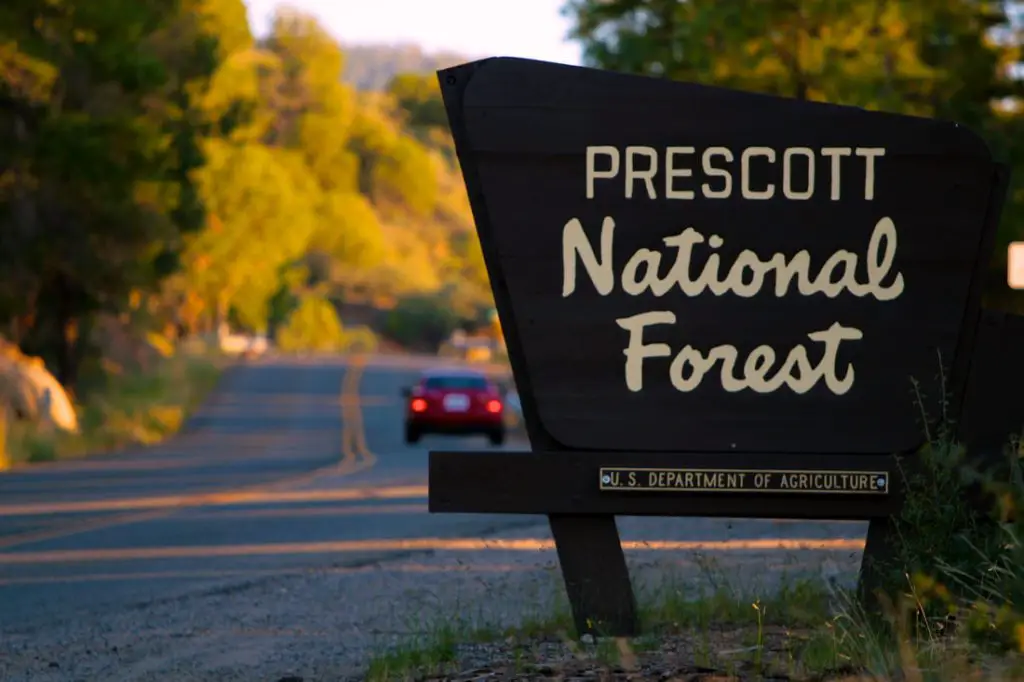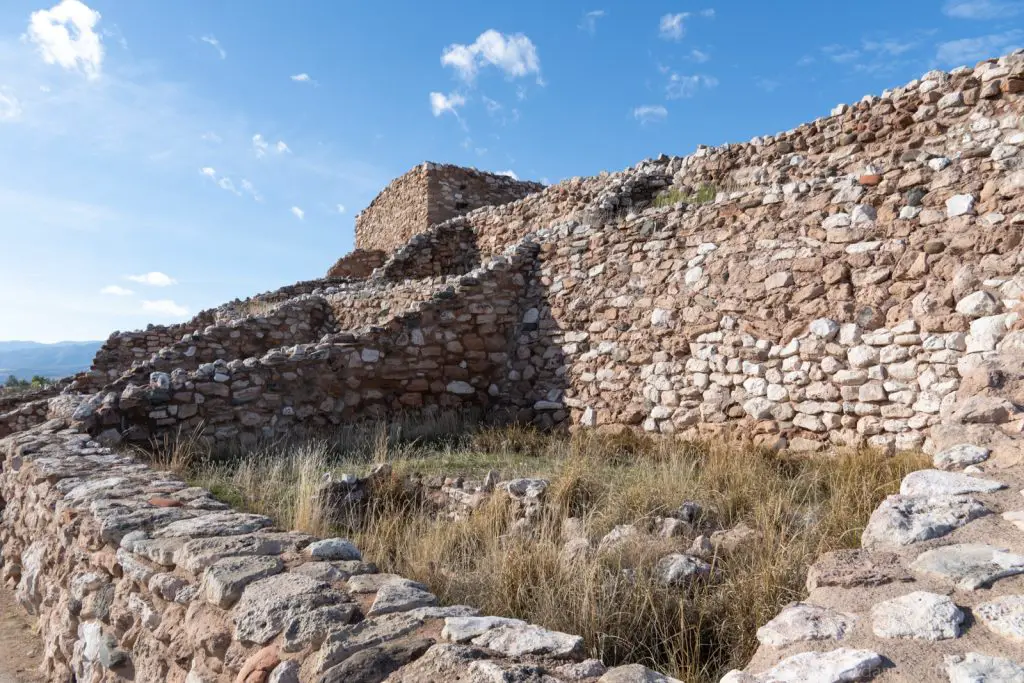Nestled in the heart of Arizona lies a vast expanse of wilderness rich in history and natural beauty – the Prescott National Forest. This treasure trove of over half a million acres of land invites you to explore a world that beautifully entwines past and present.

Journey with us as we uncover the stories hidden within the historic sites of Prescott National Forest, breathing life into tales that shaped America as we know it today.
Geography and Natural Aspects of Prescott National Forest
Perched within the Bradshaw Mountains, Prescott National Forest encompasses a diverse array of landscapes – from towering peaks to sweeping grasslands, all teeming with vibrant life. This rugged terrain is home to several unique species of flora and fauna, including the majestically towering Ponderosa Pines and wildlife like the mule deer and coyotes. Prescott National Forest is indeed a paradise for biodiversity.
The Forest’s dramatic topography is not just an allure for nature enthusiasts but also a canvas on which history has painted vivid tales, making it an enticing destination for those seeking to unravel the mysteries of the past.
Native American History in Prescott National Forest
Before the wave of European settlers swept across the North American continent, the region now known as the Prescott National Forest was home to Native American tribes. Their rich heritage is echoed through the numerous archaeological sites scattered across the Forest.
Notably, the Sinagua, Hohokam, and Yavapai tribes found sustenance and shelter in these lands. These tribes’ legacy, especially evident in the Fitzmaurice Ruin, an ancient pueblo from the 13th century, gives us glimpses into their unique societal structures and way of life. Besides, the Verde River – one of Arizona’s last free-flowing river systems – served as a critical lifeline for these communities, underscoring the symbiotic relationship between humans and nature.
The Gold Rush Era in Prescott National Forest
The discovery of gold in the mid-19th century dramatically transformed the Prescott National Forest. The gleam of the precious metal enticed many prospectors and settlers, marking an era that has left its indelible imprint on the region.
Areas like Lynx Creek and the Hassayampa River carry the legacy of this gold rush era. Today, they stand as popular recreational sites where one can stumble upon relics of the past – from the vestiges of mines to remnants of settlements. The Blue Bell Mine, an abandoned gold and copper mine, tells a silent tale of the dreams and ambitions that brought people to these lands.
Fort Whipple: A Historic Military Installation
Fort Whipple, established in 1864, was a strategic military installation that significantly shaped the history of the Prescott National Forest and surrounding areas. This fort, located near Prescott, played a crucial role during the Indian Wars and later served as a military hospital.
Now, Fort Whipple houses a museum showcasing various artifacts that narrate its intriguing past. Historic weaponry, uniforms, medical equipment, and more – all serve as silent storytellers of a bygone era. A visit to Fort Whipple Museum is truly a journey back in time.
Prescott National Forest during the Civil War
Despite its geographical distance from the main theatres of conflict, the Prescott National Forest was not untouched by the tremors of the Civil War. Its strategic position and the wealth of resources it offered made it a significant player in civil unrest.

During the Civil War, the region, a part of the New Mexico Territory, witnessed several skirmishes and military movements. Fort Whipple served as a stronghold for Union troops, reinforcing its significance in this turbulent chapter of history.
Historic Fire Lookouts in Prescott National Forest
Historic fire lookouts, integral to forest management, pepper the landscape of Prescott National Forest. Erected during the early 20th century, these structures are silent guardians of the forest’s well-being.
Prominent among them is the Baker Butte Lookout, established in the 1930s and operational even today. Overlooking the sprawling forest, the Baker Butte Lookout stands as a testament to the tireless efforts in forest conservation and the battle against forest fires.
Ranching History in Prescott National Forest
Ranching was a cornerstone of life in the Prescott National Forest in the late 19th and early 20th centuries. Many ranches established during this period played pivotal roles in shaping the region’s economy and culture.
The Bannie Mine and Ranch, established in the 1890s, is a notable example. This place was once a thriving hub for cattle and sheep ranching and mining. Today, it stands as a living relic of a time when the settlers’ industrious spirit breathed life into the region.
Historic Trails of Prescott National Forest
The vast expanse of Prescott National Forest is crisscrossed by numerous historic trails that bear testament to its rich past. Once treaded by Native Americans, miners, and settlers, these trails now serve as popular routes for hiking and horseback riding.
Among these trails, the General Crook Trail holds a special place in history. Named after General George Crook, this trail was extensively used by military forces during the Indian Wars. Now, it serves as a pathway for history enthusiasts to walk back in time.
Conservation Efforts and the Creation of the Forest Reserve
The establishment of Prescott National Forest in 1898 was a part of the broader conservation movement in the United States. The creation of this forest reserve was instrumental in protecting not only the area’s natural resources but also its historic sites.

Early conservation efforts, focused on curbing overgrazing and preserving watersheds, were led by pioneers like Gifford Pinchot, the first Chief of the U.S. Forest Service. Their relentless work laid the foundation for the conservation efforts that continue today.
Visiting Prescott National Forest: An Adventure in History
Visiting the historic sites of Prescott National Forest offers a unique blend of adventure and history. There’s much to explore, from hiking trails to museum exhibits, and every corner holds a piece of the past waiting to be discovered.
Preparation is key when planning your visit. Knowing the rules and regulations, carrying appropriate gear, and maintaining respect for both the natural environment and the historic sites ensures a rewarding experience.
The Future of Prescott National Forest’s Historic Sites
As we look towards the future, the preservation of Prescott National Forest’s historic sites becomes increasingly critical. These sites are not just physical structures or remnants of the past, but invaluable pieces of our collective heritage. They offer unique insights into our history, culture, and the relationship between humanity and the environment over the centuries.
Active preservation efforts, including archaeological research, restoration projects, and educational programs, are currently being undertaken to safeguard these sites. These initiatives are crucial for ensuring that future generations can appreciate and learn from the rich tapestry of the past that the Prescott National Forest embodies.

In line with this, there’s also a growing emphasis on sustainable tourism. Practices such as following the ‘leave no trace principle and sticking to designated trails help protect the historic sites and their surrounding environments. Engaging with local guides and park rangers can enrich your understanding of the area while contributing to the local economy and conservation efforts.
FAQ:
In this section, we will be delving into some of the most common inquiries and curiosities that surround our topic.
Can I visit all the historic sites in Prescott National Forest?
Most of the historic sites within Prescott National Forest are accessible to the public. However, some areas may have restricted access due to preservation work or safety reasons. It’s always best to check the latest updates on the Forest Service’s official website or contact the local ranger station before planning your visit.
Are there guided tours available in the Forest?
Yes, guided tours are available for some historic sites, including the Fort Whipple Museum. Local guides and park rangers offer in-depth insights into the history and significance of these sites. For specific details and schedules, refer to the official website or get in touch with the local ranger station.
Are there any specific rules or regulations I need to follow while visiting the historic sites?
Visitors are expected to follow the guidelines laid down by the Forest Service, which include respecting the natural and cultural heritage, adhering to designated trails, and not removing any artifacts. Specific rules may apply to different sites, so it’s advisable to familiarize yourself with these before your visit.
How can I contribute to the preservation of the Forest’s historic sites?
You can contribute to the preservation efforts in many ways, such as respecting the rules during your visit, participating in volunteer programs, or making a donation to conservation organizations. Every effort, no matter how small, counts.
Conclusion
Prescott National Forest is much more than a natural sanctuary – it’s a living museum echoing the tales of Native Americans, prospectors, ranchers, soldiers, and conservationists. The historic sites within its bounds are a testament to the enduring spirit of humanity and its entangled relationship with the natural world.
Each visit offers a unique opportunity to tread the pathways of history and leave with a greater understanding of our past and the pressing need to preserve these landmarks for the future.
Whether you’re a history buff, a nature enthusiast, or simply an adventurer at heart, the historic sites in Prescott National Forest promise an experience filled with learning, discovery, and an unforgettable connection with the past. So, step into this land where history meets nature, and let the journey into the annals of time begin.



Leave a Comment
You must be logged in to post a comment.